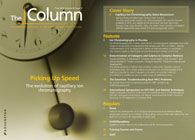N–glycan Biopharmaceutical Reference Library
Thirty percent of approved drugs will be based on recombinant monoclonal antibody (rMab) drugs over the next 10 years. Glycosylation, the convalent addition of carbohydrates to proteins, can influence properties of rMab drugs and has to be closely monitored during drug development and production. Scientists from the University of California (California, USA) have developed a new liquid chromatography–mass spectrometry (LC–MS) N-glycan library based on eight commercially available recombinant monoclonal antibodies, for the rapid identification of glycosylated structures.
Thirty percent of approved drugs will be based on recombinant monoclonal antibody (rMab) drugs over the next 10 years.1 Glycosylation, the convalent addition of carbohydrates to proteins, can influence properties of rMab drugs and has to be closely monitored during drug development and production. Scientists from the University of California (California, USA) have developed a new liquid chromatography–mass spectrometry (LC–MS) N-glycan library based on eight commercially available recombinant monoclonal antibodies, for the rapid identification of glycosylated structures.1
Carlito Lebrilla, corresponding author of the study, told The Column: “Many of today’s antibody drugs were developed over a decade ago when our methods for the analysis of the glycan were not as advanced. For this reason, there is very little relative effort spent on characterizing glycosylation.” This is now changing, according to Lebrilla, with the emergence of biosimilars and other biologics.
Eight commercial rMab drugs were treated to release N-glycans that were then separated on a porous graphitized column on a chip, and then analyzed using electrospray ionization hybrid quadrupole time-of-flight mass spectrometry (ESI–Q–TOF–MS). The retention time and accurate mass for over 70 structures was recorded within the library, allowing identification of glycosylated structures by matching LC retention times and accurate masses. - B.D.
Reference
1. T. Song, S. Ozcan, A. Becker, and C.B. Lebrilla, Analytical Chemistry DOI: 10.1021/ac501102t (2014).
This story originally appeared in The Column. Click here to view that issue.

Determining the Link Between Prenatal Cannabis Use and Symptoms of Depression Using LC–MS/MS
April 16th 2025Researchers investigating the relationship between cannabis use during pregnancy and depressive symptoms—and whether continued use beyond the first trimester or higher levels of use were linked to increased symptoms—used liquid chromatography–tandem mass spectrometry (LC–MS/MS) to confirm the presence of 11-nor-9-carboxy-delta-9-tetrahydrocannabinol (THC-COOH) in urine samples.
A Guide to (U)HPLC Column Selection for Protein Analysis
April 16th 2025Analytical scientists are faced with the task of finding the right column from an almost unmanageable range of products. This paper focuses on columns that enable protein analysis under native conditions through size exclusion, hydrophobic interaction, and ion exchange chromatography. It will highlight the different column characteristics—pore size, particle size, base matrices, column dimensions, ligands—and which questions will help decide which columns to use.










